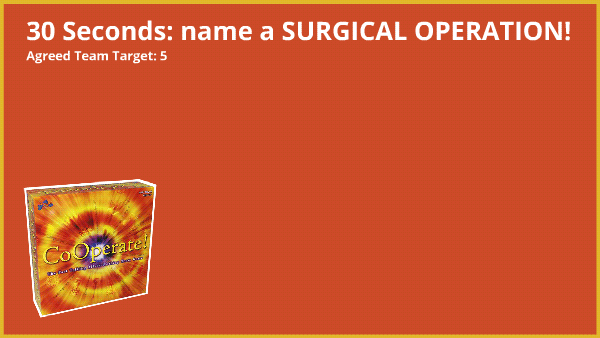
CoOperate - the Walkthrough!
It’s the fast talking all-or-nothing team game!
You’ve got your best besties and favourite family around you. You’ve split into two teams. You’ll want to get going!
So here are our fast talking tips and an all-or-nothing walkthrough on The Stuff You Need To Know. Good luck, enjoy, and we’ll start off with…
The Big Decision
Which of the three ways to play?
- ANARCHY (all shouting at once) – by far the noisiest! Choose this if you’re big personalities who aren’t afraid of chaos! But it can be tricky to score, especially if there’s a big group.
- ORDER (take it in turns; passes allowed) – easiest and most inclusive; go for this one if your team includes kids, or players who lean towards the terminally hopeless.
- PRESSURE (no passes allowed) – sit back and relish those rabbit-in-headlights moments when an individual opponent finds themselves utterly stumped. Not for beginners, or the less confident.
TIP: ‘Anarchy’ games can be further enlivened by insisting that – if they’re able – players must stand up, or raise their hands, when answering. This can help with the scoring, also.
‘Pressure’ games tend to take a little longer, as teams will fail to hit their target more often.

The first timer phase
Here’s where your team needs to declare your target number of correct answers.
The core strategy is obvious: balance your drive to win the game with some hard realism! You’ll soon get to know your team’s strengths and weaknesses.
Building up a big lead will allow you more breathing space when you choose a target… or conversely you might find yourself in a position where caution must be thrown to the wind.
Remember, some types of challenge will take longer to answer than others! LISTs are generally the quickest; DESCRIBEs can be much slower.
Keep half an eye on the challenge type that you’d land on if you achieve your target score. So if your team has failed repeatedly on those LINK challenges, then choose a target number that won’t plonk you on a green square.
Above all: DON’T FAFF. If you can’t agree on a target number, you forfeit the turn. And nobody wants to see that, do they?
The challenge types
Before throwing yourself into the game, you might want to practice on a couple of challenges first. But we warn you: it’s much, much harder with the timer going and everybody staring at you.
The challenge types – starting with the simplest - are:
- LIST PLAY (red)
Example: ‘Oceans’. Correct answers might be ‘Atlantic,’ ‘Pacific,’ ‘Billy,’ etc. One point for each correct answer. - WORD PLAY (blue)
Example: ‘Words starting with FR’. ‘Frost,’ ‘freeze,’ ‘frightening,’ etc. One point for each correct answer. - DESCRIBE PLAY (yellow)
Example: ‘Describe an animal you might see on safari’.
Here, take turns to describe a different item that would fit the bill. ‘Very long neck to eat leaves from the trees’. ‘Enormous fierce cat with a mane’. One point’s awarded for each, but only after the subject of each description (‘giraffe,’ ‘lion’) has been guessed by the player’s team mates.
Only describing is allowed! No gesticulating, no sounds-like, no starts-with, no pointing! - LINK PLAY (green)
There are two types of LINK play:
Pairs – for example: ‘First a country, then the colours of its flag.’
Sequences – for example: ‘An animal heavier than the last’.
For pairs, two players combine for each answer. (First player: ‘France!’. Second player: ‘Red, white and blue!’). And you score only ONE point per COMPLETED, CORRECT pair.
For sequences, the whole team answers in – ahhh – sequence. And you score one point for EACH CORRECT ANSWER in the sequence. (‘Mouse!’, ‘Cat!’, ‘Sheep!’ etc.) Clearly a good strategy here is for the first player not to kick off with ‘elephant.’

Bonus Moves
A last word about the ‘Move On’ squares. Land on one of these and roll the dimple die!
- A COLOUR means: move on to the next space of that colour!
- A GREY means: roll again!
- A CORNER DIMPLE means: move on four spaces!
It's as simple as that! Have fun, be kind to your team mates, co-operate!

